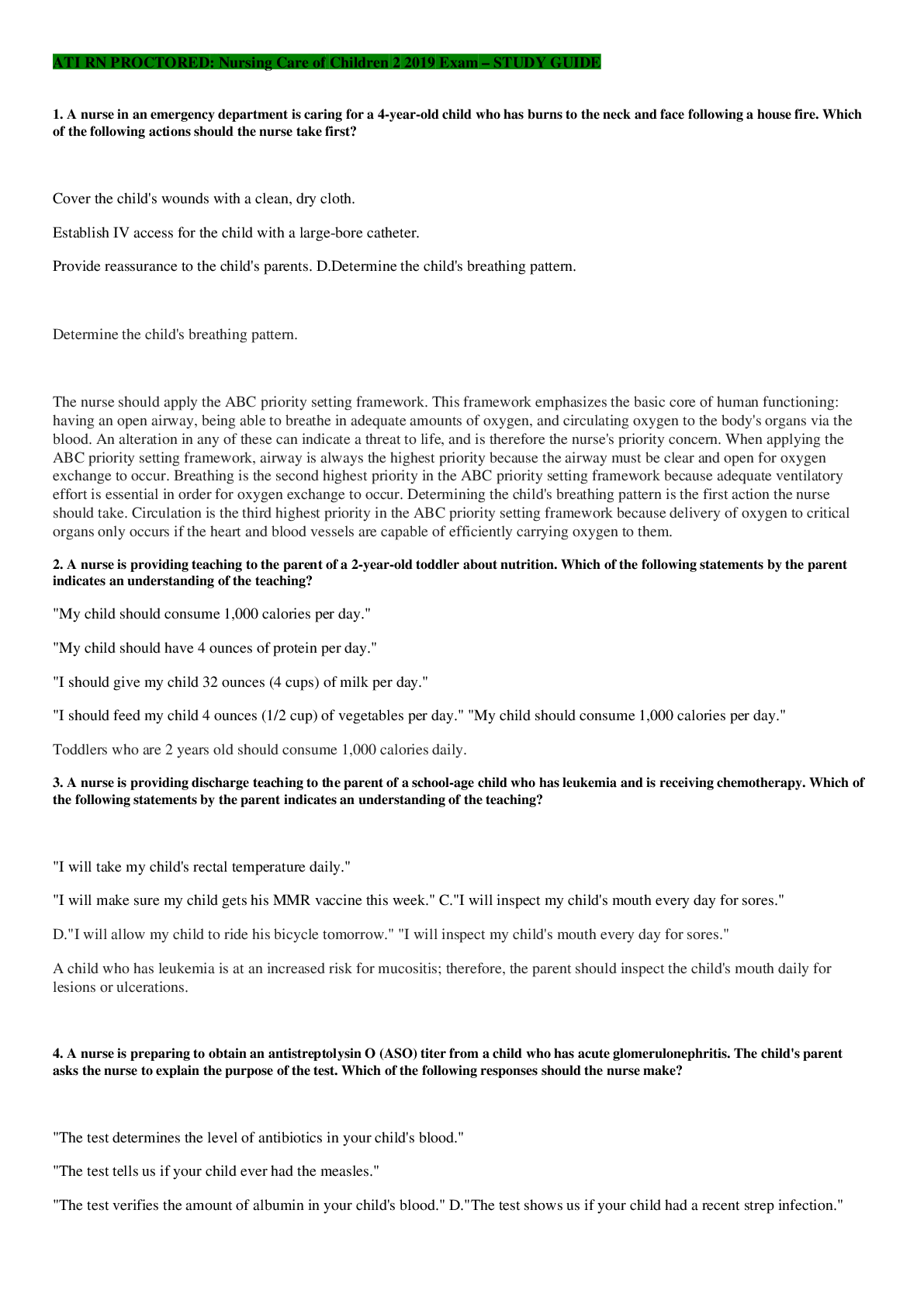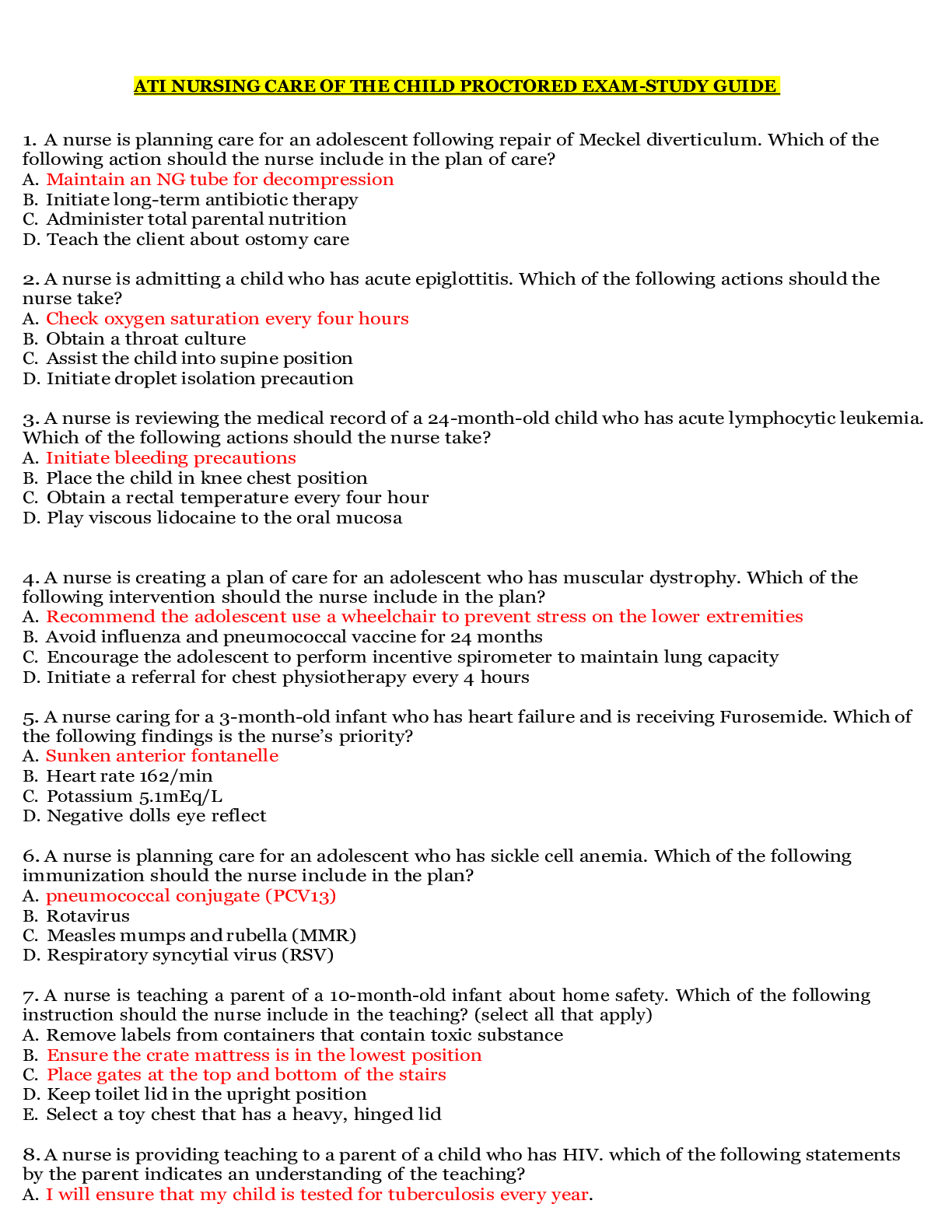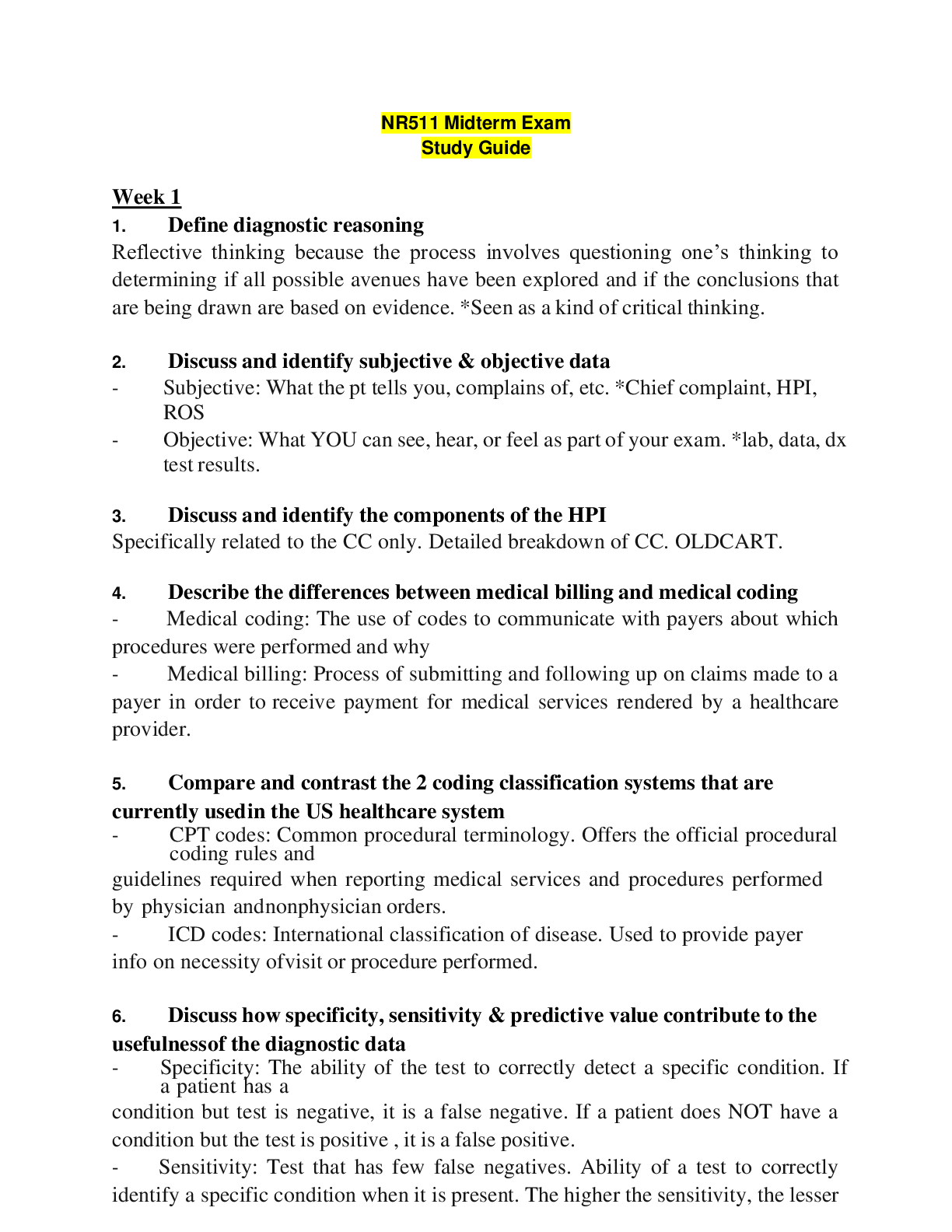*NURSING > STUDY GUIDE > RN VATI NURSING CARE OF CHILDREN ASSESSMENT REMEDIATION LATEST 2022 ALREADY PASSED (All)
RN VATI NURSING CARE OF CHILDREN ASSESSMENT REMEDIATION LATEST 2022 ALREADY PASSED
Document Content and Description Below
RN VATI NURSING CARE OF CHILDREN ASSESSMENT REMEDIATION Management of Care – (1) Collaboration with Interdisciplinary Team – (1) Asthma: Priority Finding to Report (Active Learning ... Template – System Disorder, RM NCC RN 10.0 Chp 18) Signs of an asthma exacerbation – decreased PEFR, increased use of SABA, difficulty speaking or eating Status asthmaticus – a life-threatening episode of airway obstruction that is often unresponsive to common treatment Manifestations: include wheezing, labored breathing, nasal flaring, lack of air movement in lungs, use of accessory muscles, distended neck veins, and risk for cardiac and respiratory arrest Respiratory failure – persistent hypoxemia related to asthma can lead to respiratory failure Safety and Infection Control – (3) Accident/Error/Injury Prevention – (1) Health Promotion of Toddlers (1 to 3 Years): Teaching a Parent About Injury Prevention (Active Learning Template – Basic Concept, RM NCC RN 10.0 Chp 4) Aspiration of foreign objects – small object that can become lodged in the throat should be avoided. Toys that have small parts should be kept out of reach. Ageappropriate toys should be provided. Clothing should be checked for safety hazards. Balloons should be kept away from toddlers. Parents should know emergency procedures for choking. Bodily harm – sharp objects should be kept out of reach. Firearms should be kept in locked boxes or cabinets. Toddlers should not be left unattended with any animals present. Toddlers should be taught stranger safety. Burns – the temperature of bath water should be checked. Thermostats on hot water heaters should be turned down to less than 49’C (120’F). Working smoke detectors should be kept in the home. Pot handles should be turned toward the back of the stove. Electrical outlets should be covered. Toddlers should wear sunscreen when outside. Drowning – toddlers should not be left unattended in bathtubs. Toilet lids should be kept closed. Toddlers should be closely supervised when near pools or any other body of water. Toddlers should be taught how to swim. Falls – doors and windows should be kept locked. Crib mattresses should be kep in the lowest position with the rails all the way up. Safety gates should be used across the top and bottom of stairs. Motor-vehicle injuries – infants and toddlers remain in rear-facing car seat umtil the age of 2 years or the height recommended by the manufacturer. Toddlers over the age of 2 years, or who excess the height recommendations for rear-facing car seats, are moved to a forward-facing car seat. Safest area for infants and children is in the backseat of a car. Do not place rear-facing car seats in the front seat of vehicles with deployable passenger airbags. Poisoning – exposure to lead pain should be avoided. Safety locks should be placed on cabinets that contain cleaners and other chemicals. The phone number for a poison control center should be kept near the phone. Medications should be This study source was downloaded by 100000831988016 from CourseHero.com on 04-09-2022 04:55:40 GMT -05:00 https://www.coursehero.com/file/45566684/RN-VATI-NURSING-CARE-OF-CHILDREN-ASSESSMENT-REMEDIATIONdocx/ kept in childproof containers, away from the reach of toddlers. A working carbon monoxide detector should be placed in the home. Suffocation – plastic bags should be avoided. Crib mattresses should fit tightly. Crib slats should be no farther apart than 6 cm (2.375 in). Pillows should be kept out of cribs. Drawstrings should be removed from jackets and other clothing. Home Safety – (1) Hematologic Disorders: Developing a Safety Plan for a Child Who Has Hemophilia (Active Learning Template – System Disorder, RM NCC RN 10.0 Chp 21) Teach parents to prevent bleeding at home – environment should be made as safe as possible to prevent injury. Provide a safe home and a play environment. Set activity restrictions to avoid injury. Acceptable activities include low-contact sports. While participating in these activities, children should wear protective equipment. Encourage the use of soft-bristled toothbrushes. Encourage regular exercise and physical therapy after active bleeding is controlled. Encourage the family to maintain up-to-date immunizations. Teach the importance of wearing medical identification. Teach manifestations of internal bleeding and hemarthrosis. Teach to control bleeding episodes using the RICE (rest, ice, compression, elevation) method. Encourage the family to participate in a support group Standard Precautions/Transmission-Based Precautions/Surgical Asepsis – (1) Acute and Infectious Respiratory Illnesses: Developing a Plan of Care for An Infant Who Has Respiratory Syncytial Virus (Active Learning Template – System Disorder, RM NCC RN 10.0 Chp 17) Use a cool-air vaporizer to provide humidity. Rest during febrile illness. Maintain adequate fluid intake. Infants may be given commercially prepared rehydration solutions, and older children may be given sports drinks. Administer medications using accurate dosages and appropriate time intervals. Develop strategies to decrease the spread of infection. Strategies include performing good hand hygiene; covering the nose and mouth with tissues when sneezing and coughing; properly disposing of tissues; not sharing cups, eating utensils, and towel, and keeping infected children from contact with children who are well. Seek further medical attention for the child if symptoms worse or respiratory distress occurs. Health Promotion and Maintenance – (2) Developmental Stages and Transitions – (2) Health Promotion of Infants (2 Days to 1 Year): Teaching Parents About Expected Language Development (Active Learning Template – Growth and Development, RN NCC RN 10.0 Chp 3) Crying is the first form of verbal communication. Infants cry for 1-1.5 hrs each day up to 3 weeks of age and build up to 2-4 hr by 6 weeks. Crying decreases by 12 weeks of age. Vocalizes with cooing noises by 3-4 months. Shows considerable interest in the environment by 3 months. Turns head to the sound of a rattle by 3 months. Laughs and squeals by 4 months. Makes single vowel sounds by 2 months. By 3-4 months the consonants are added. Begins speaking two-word phrases and progresses to speaking three-word phrases. Says three t five fords by the age of 1 year. Comprehends the word “no” by 9-10 months and obeys single commands accompanied by gestures. This study source was downloaded by 100000831988016 from CourseHero.com on 04-09-2022 04:55:40 GMT -05:00 https://www.coursehero.com/file/45566684/RN-VATI-NURSING-CARE-OF-CHILDREN-ASSESSMENT-REMEDIATIONdocx/ Psychosocial Issues of Infants, Children, and Adolescents: Teaching Management Strategies for Children Who Have ADHD (Active Learning Template – System Disorder, RM NCC RN 10.0 Chp 44) Behavioral strategies: positive reinforcement, rewards for good behavior, ageappropriate consequences. Modification of the environment to help the child become successful: structured environment, charts to assist with organization, decreasing stimuli in the environment, consistent study area, modeling positive behaviors, using steps when assigning chores, using pastel colors Appropriate classroom placement in school: collaborate with the school nurse, allow more time for testing, place in classroom that has order and consistent rules, offer verbal instruction combined with visual cues plan academic subjects in the morning, including regular breaks, provider for small classroom settings or work groups Psychosocial Integrity – (1) Grief and Loss – (1) Death and Dying: Mani [Show More]
Last updated: 1 year ago
Preview 1 out of 8 pages

Reviews( 0 )
Document information
Connected school, study & course
About the document
Uploaded On
Apr 09, 2022
Number of pages
8
Written in
Additional information
This document has been written for:
Uploaded
Apr 09, 2022
Downloads
0
Views
117



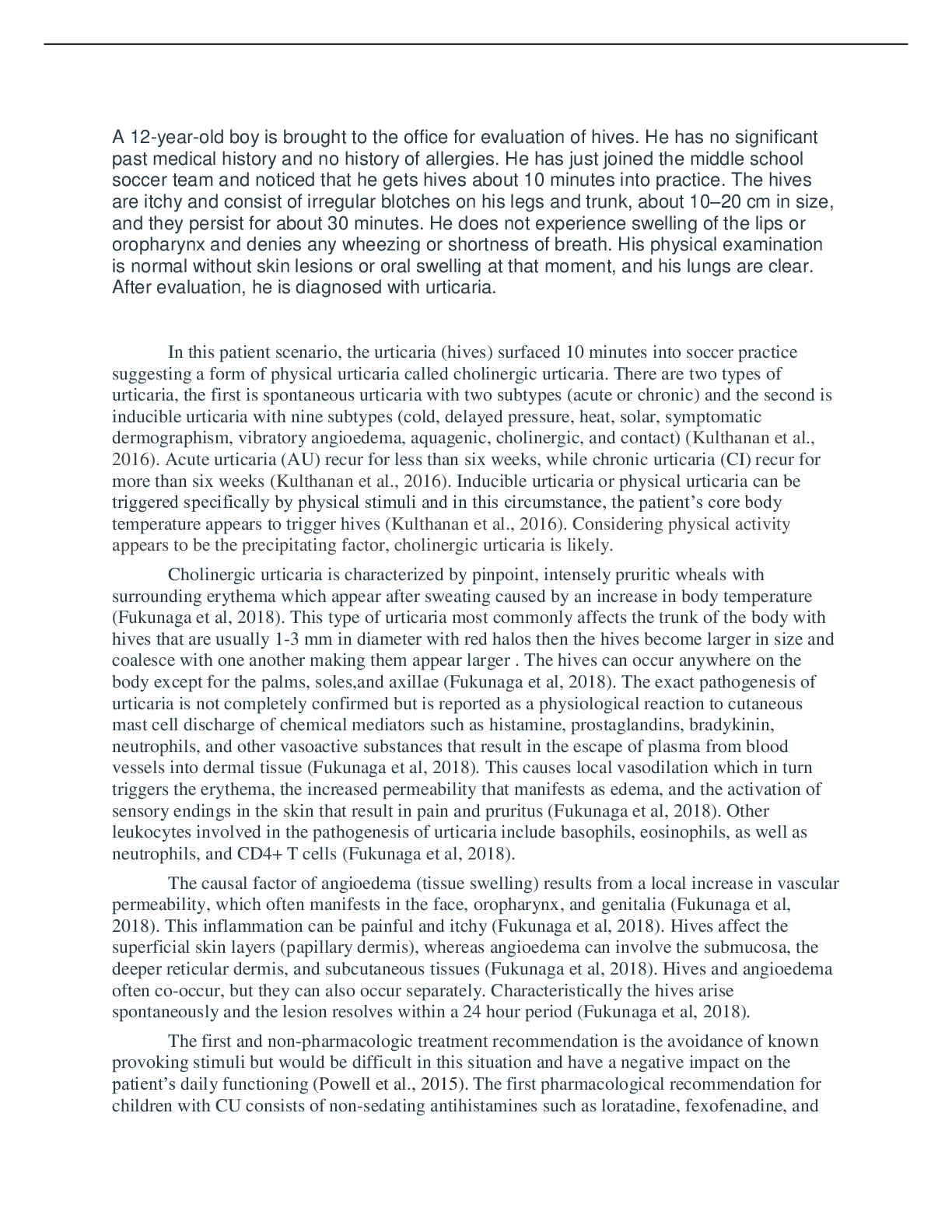
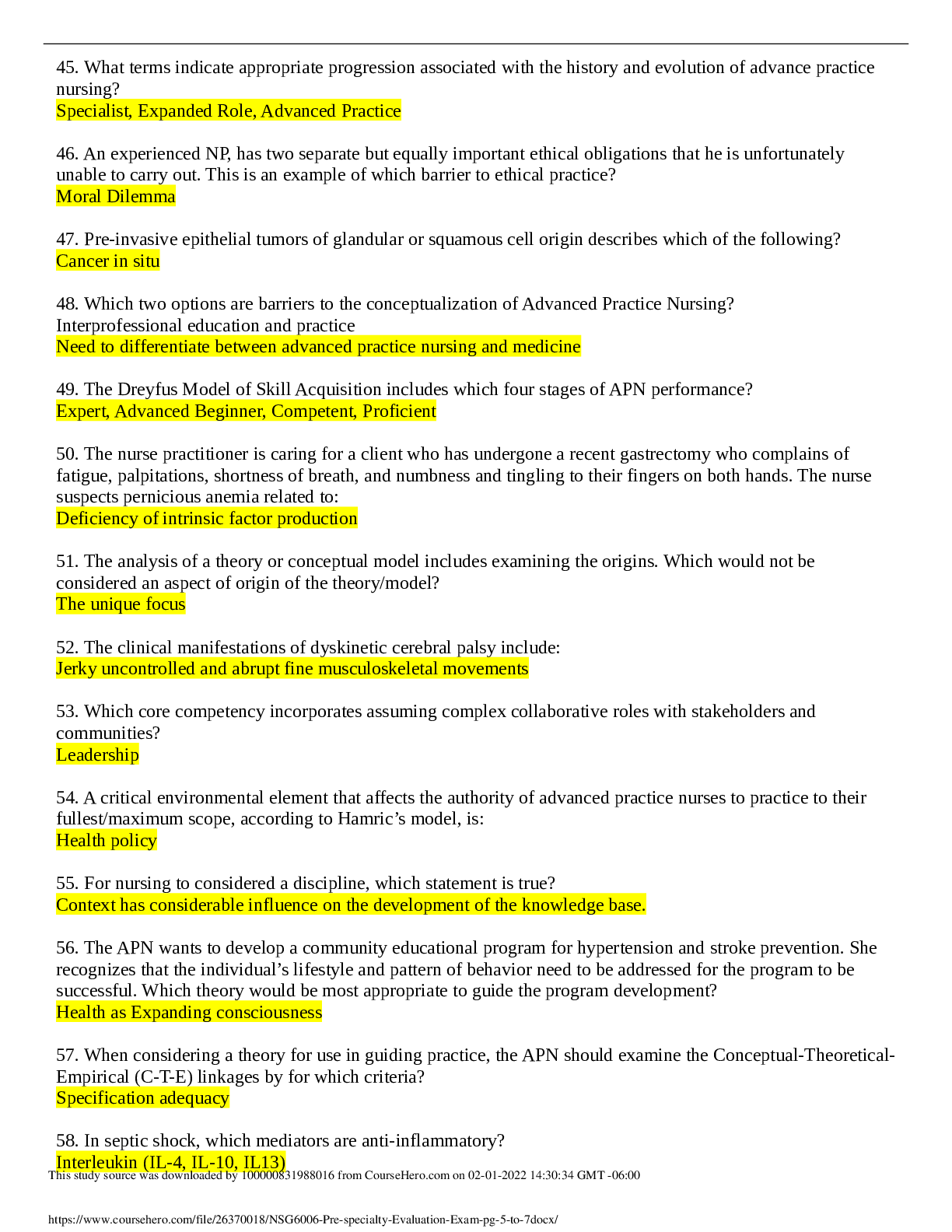


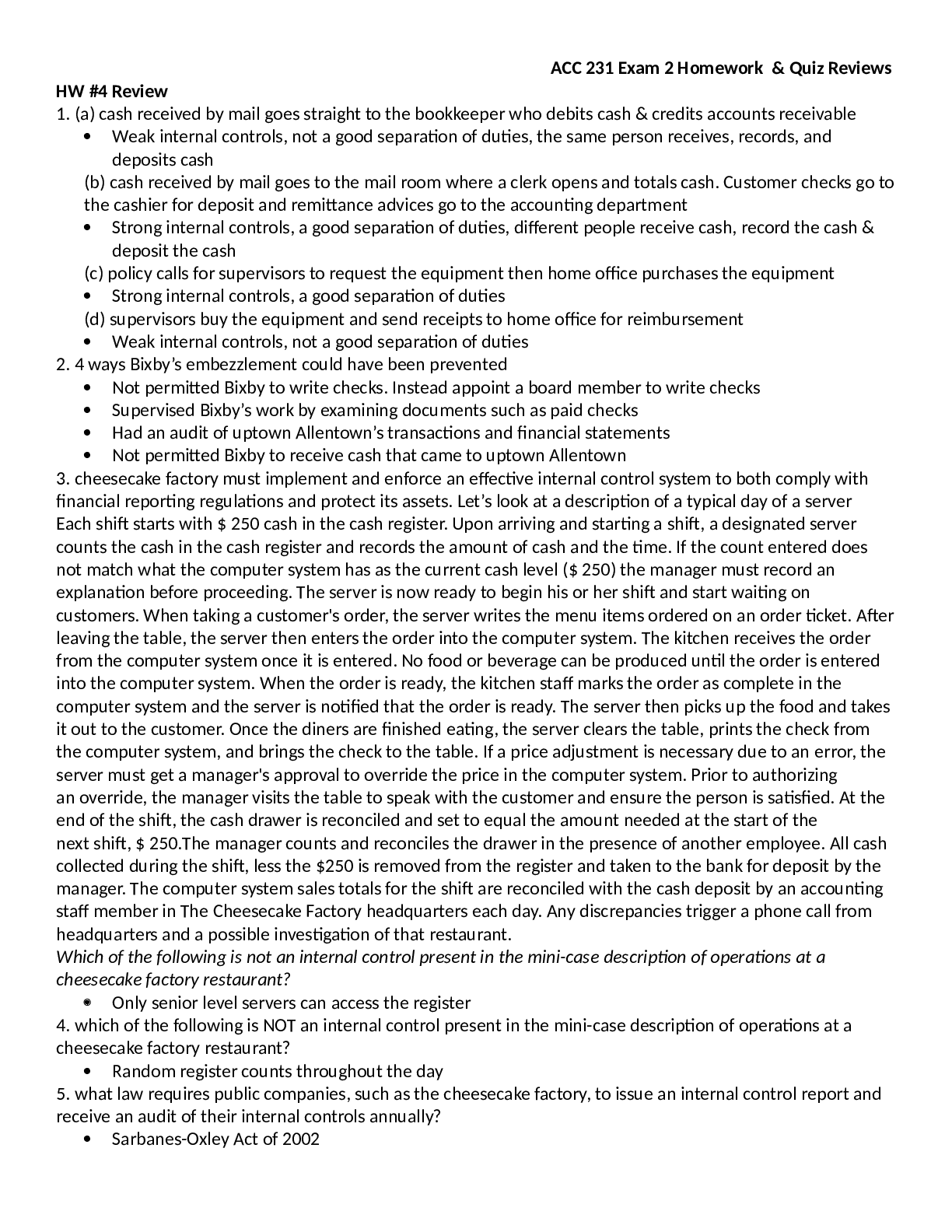

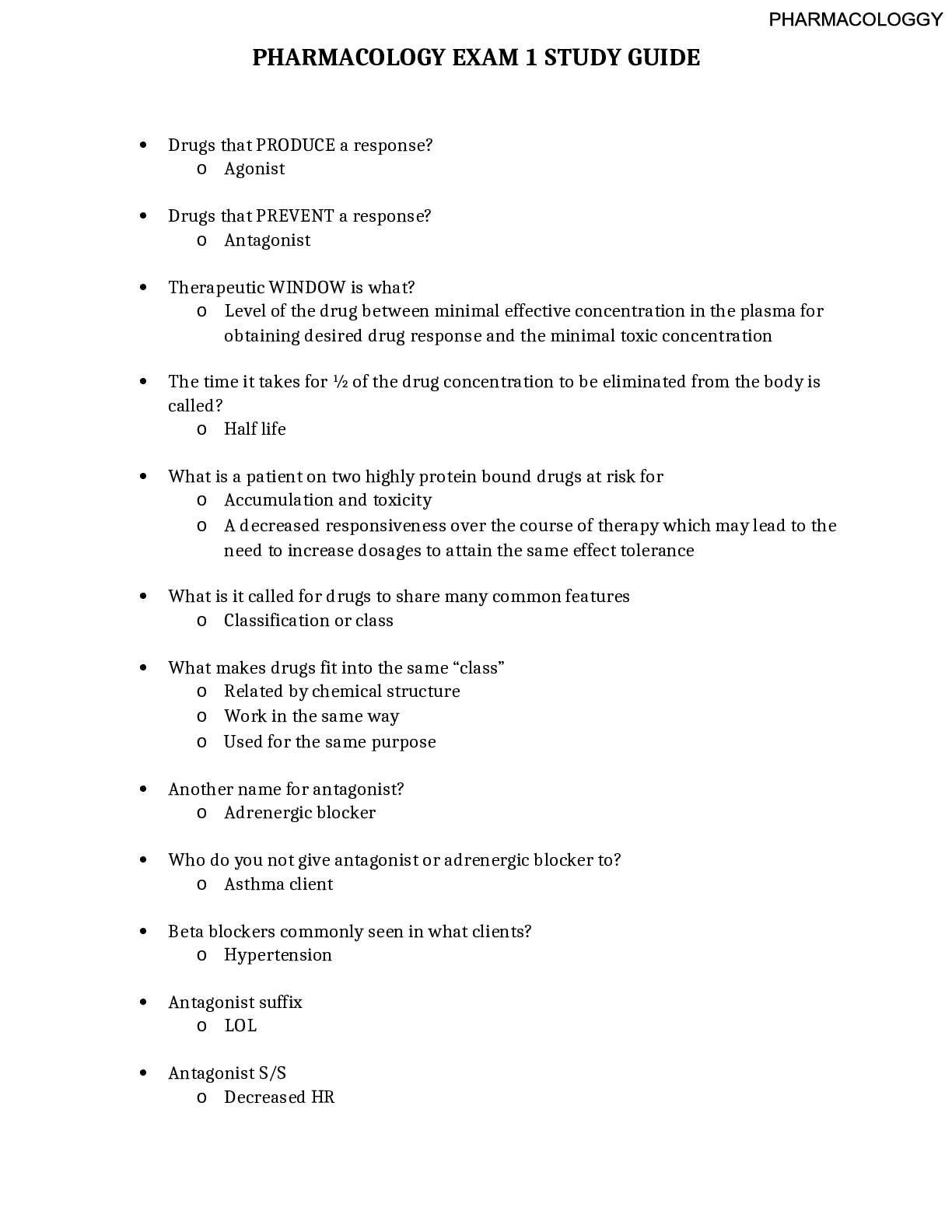
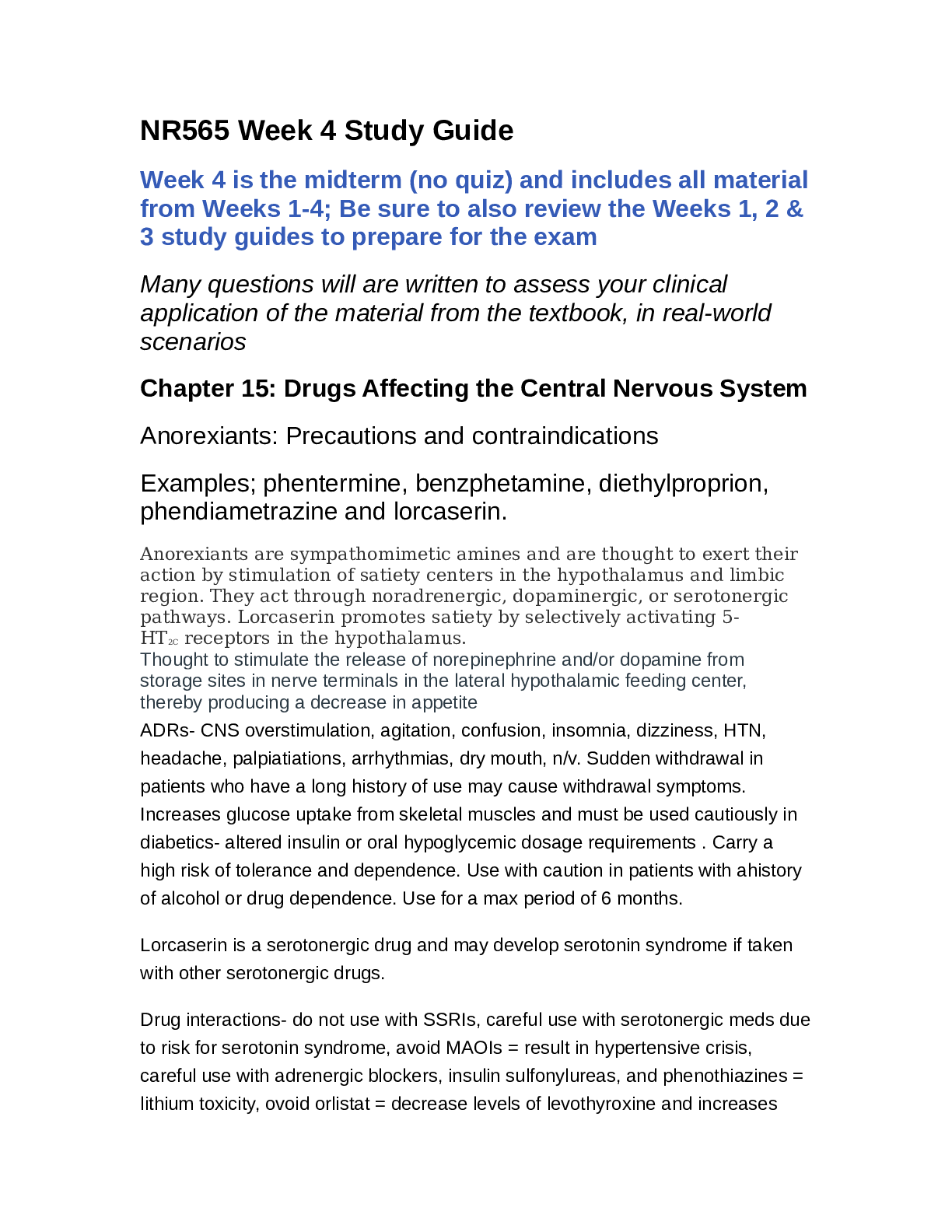



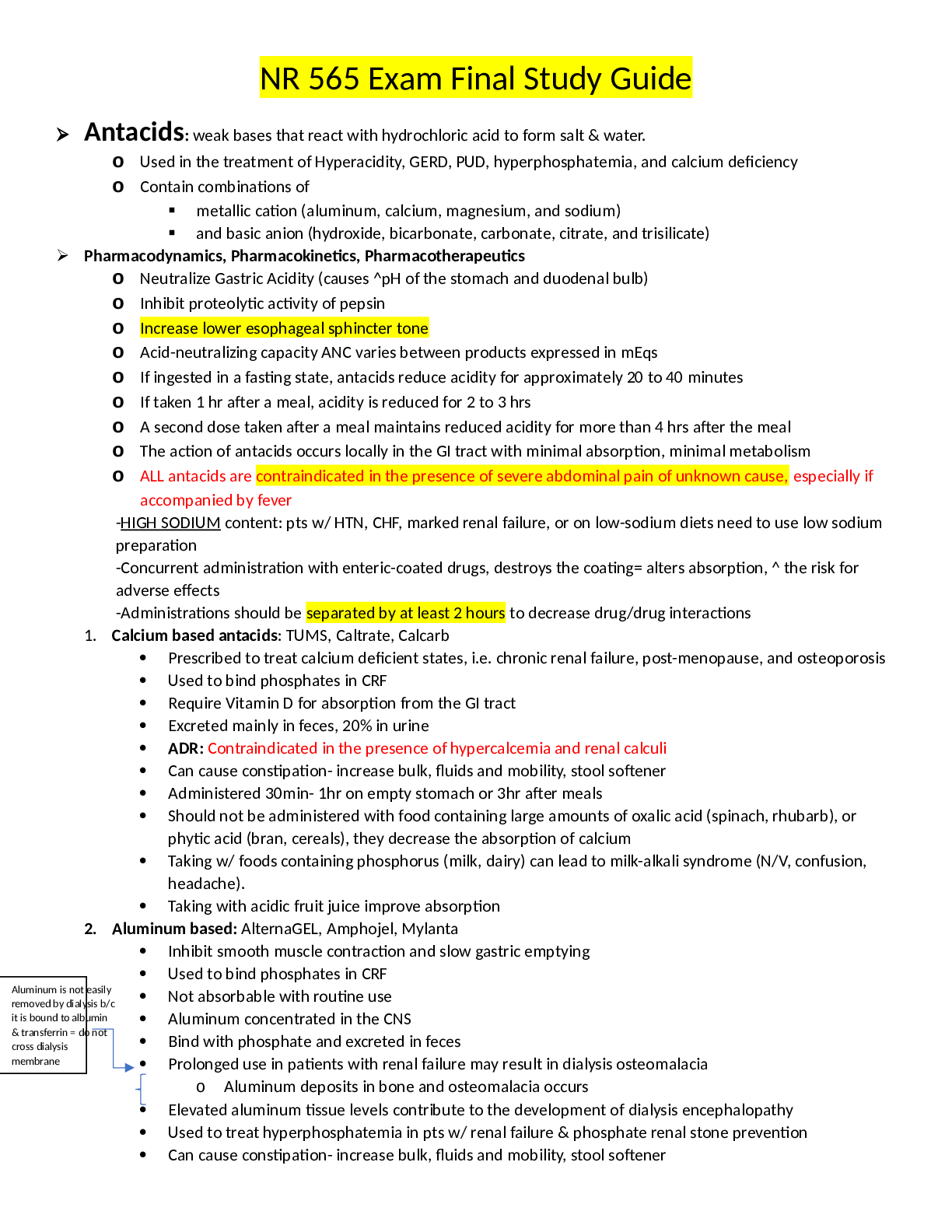
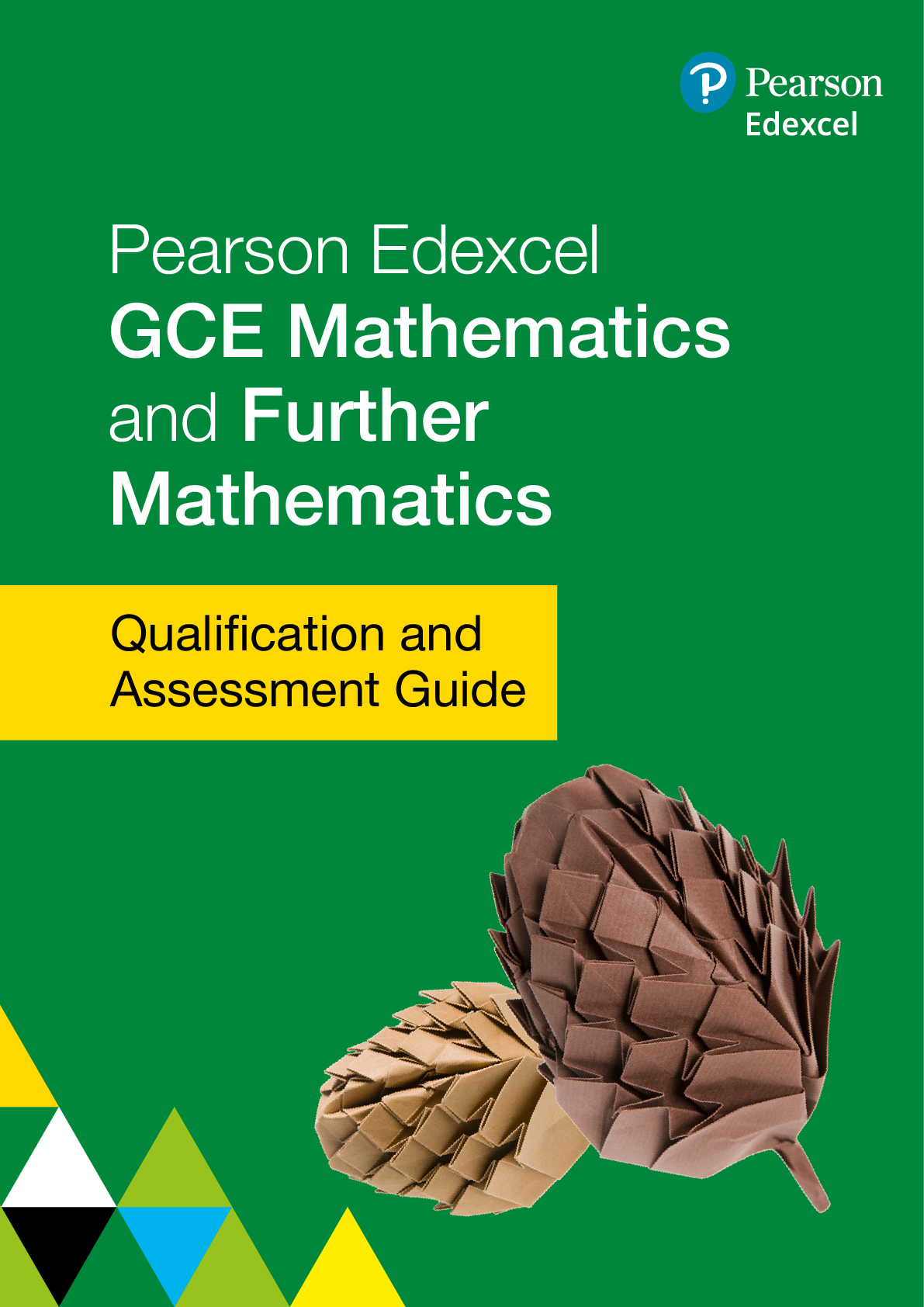


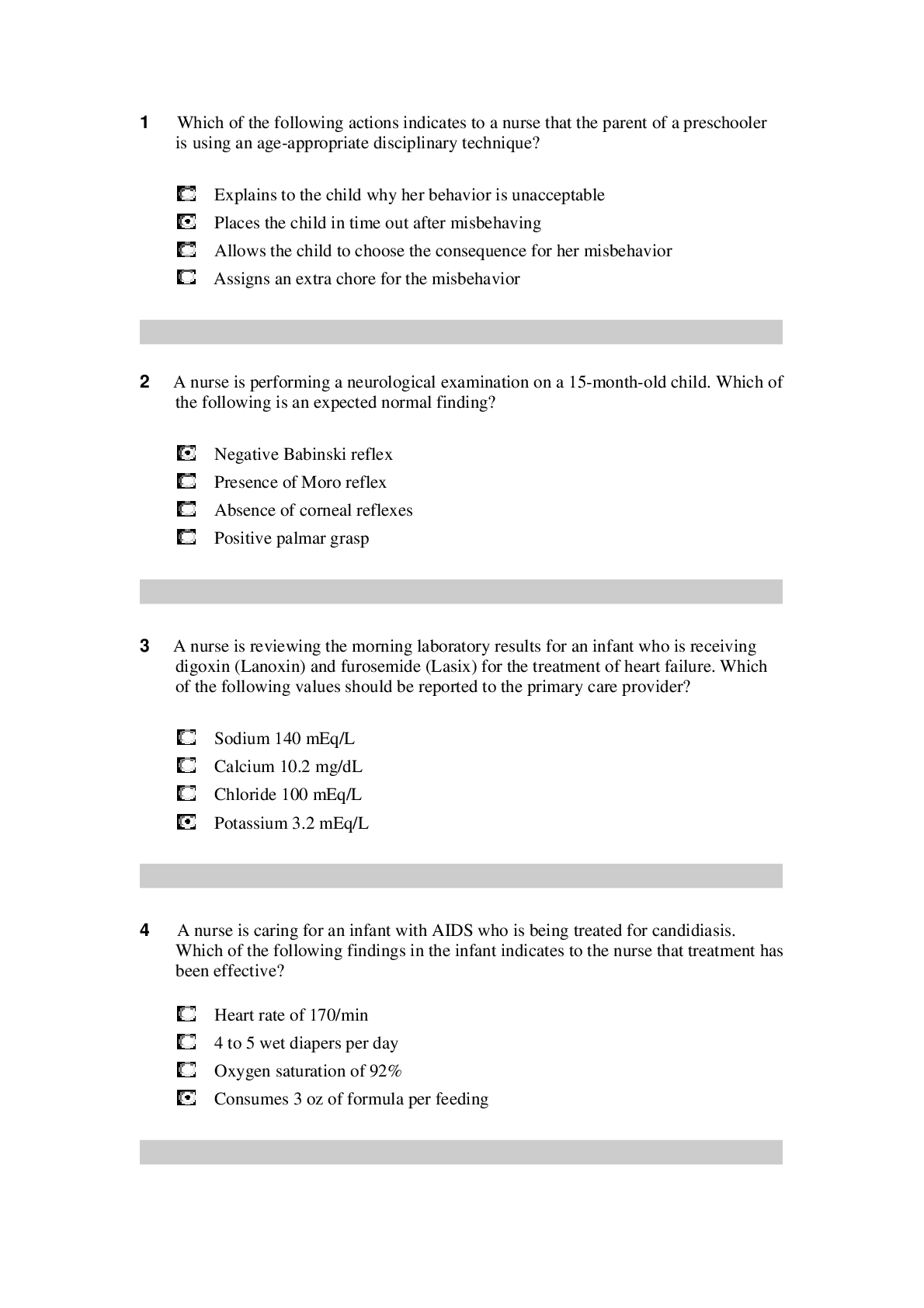
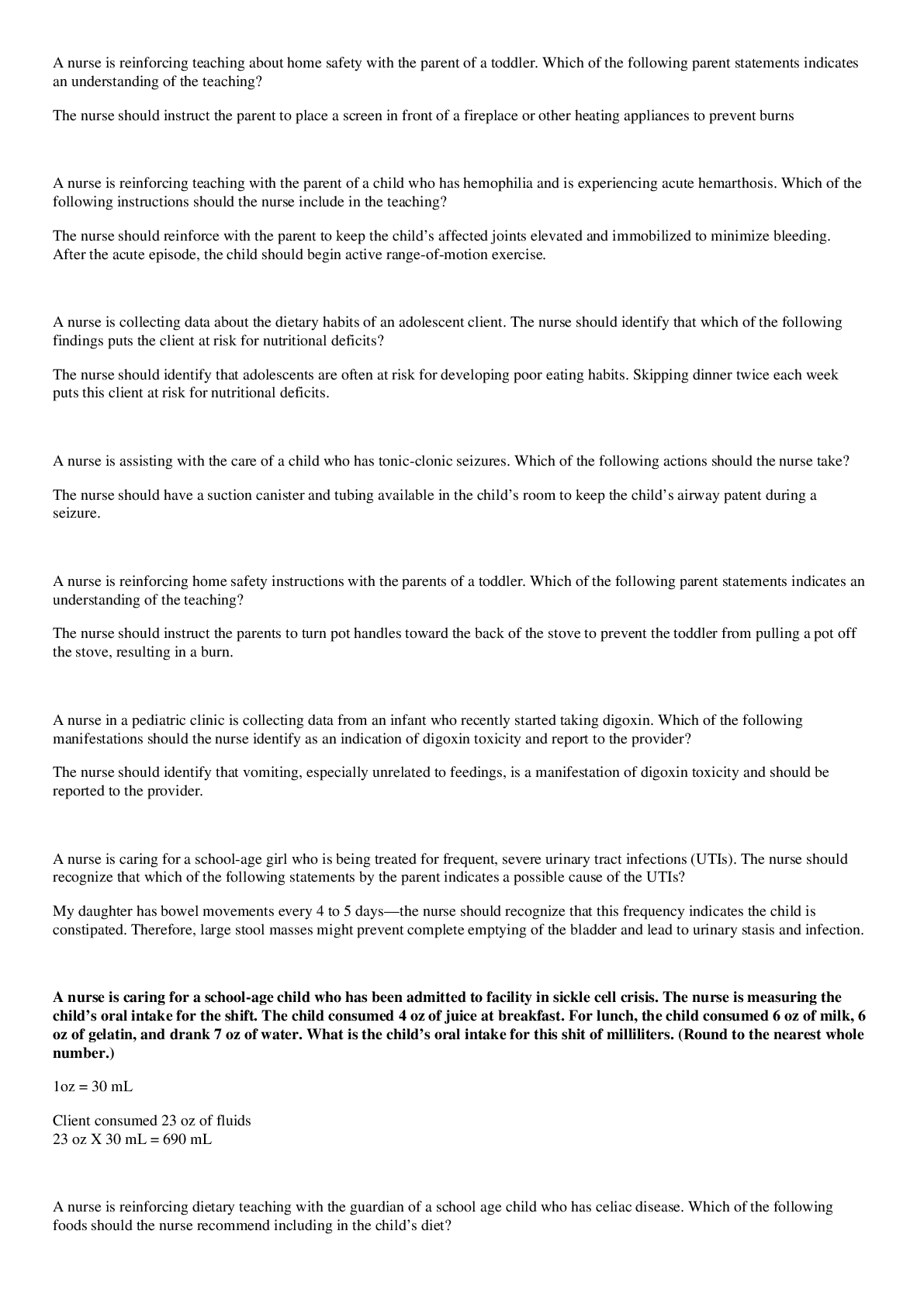
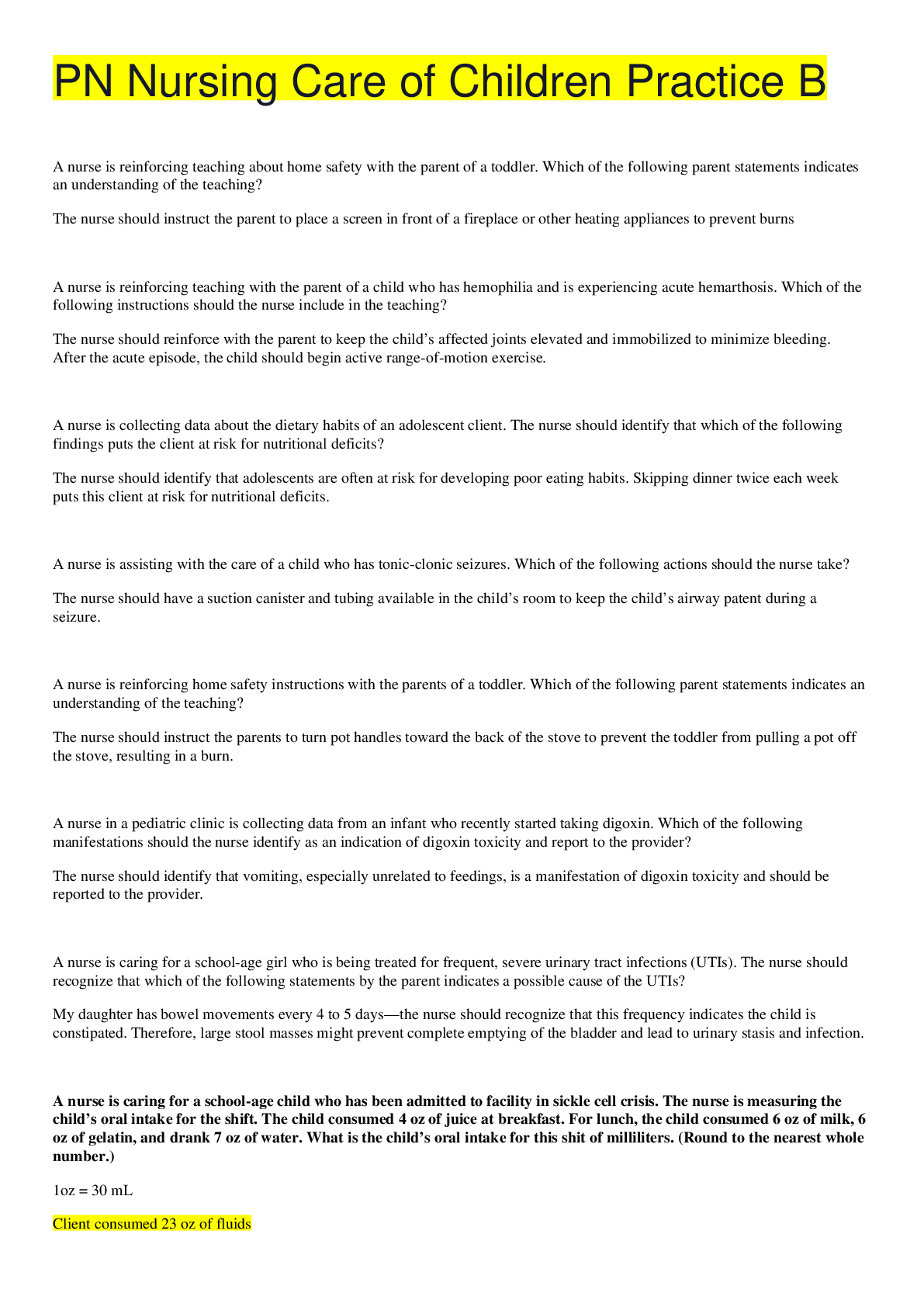
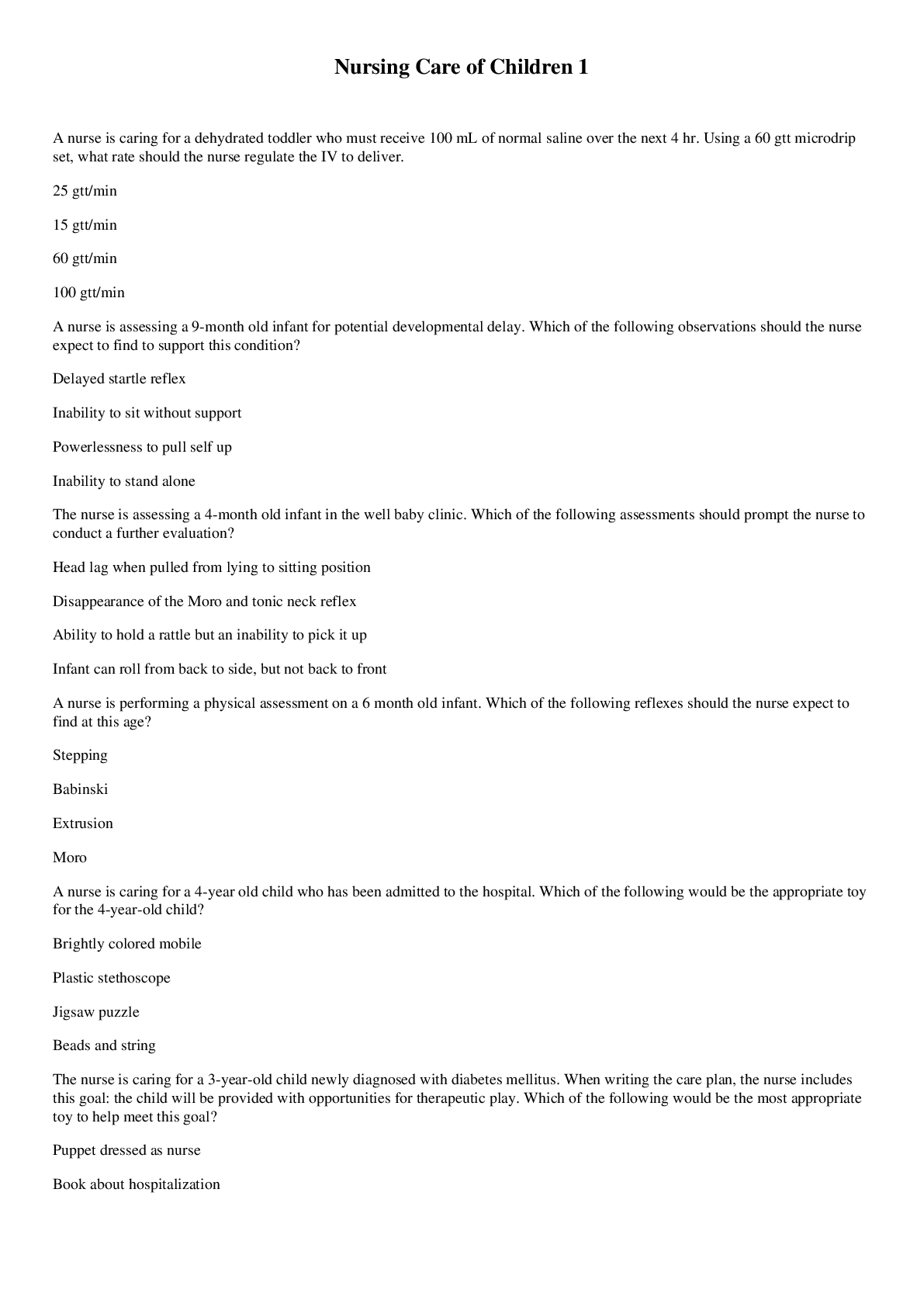
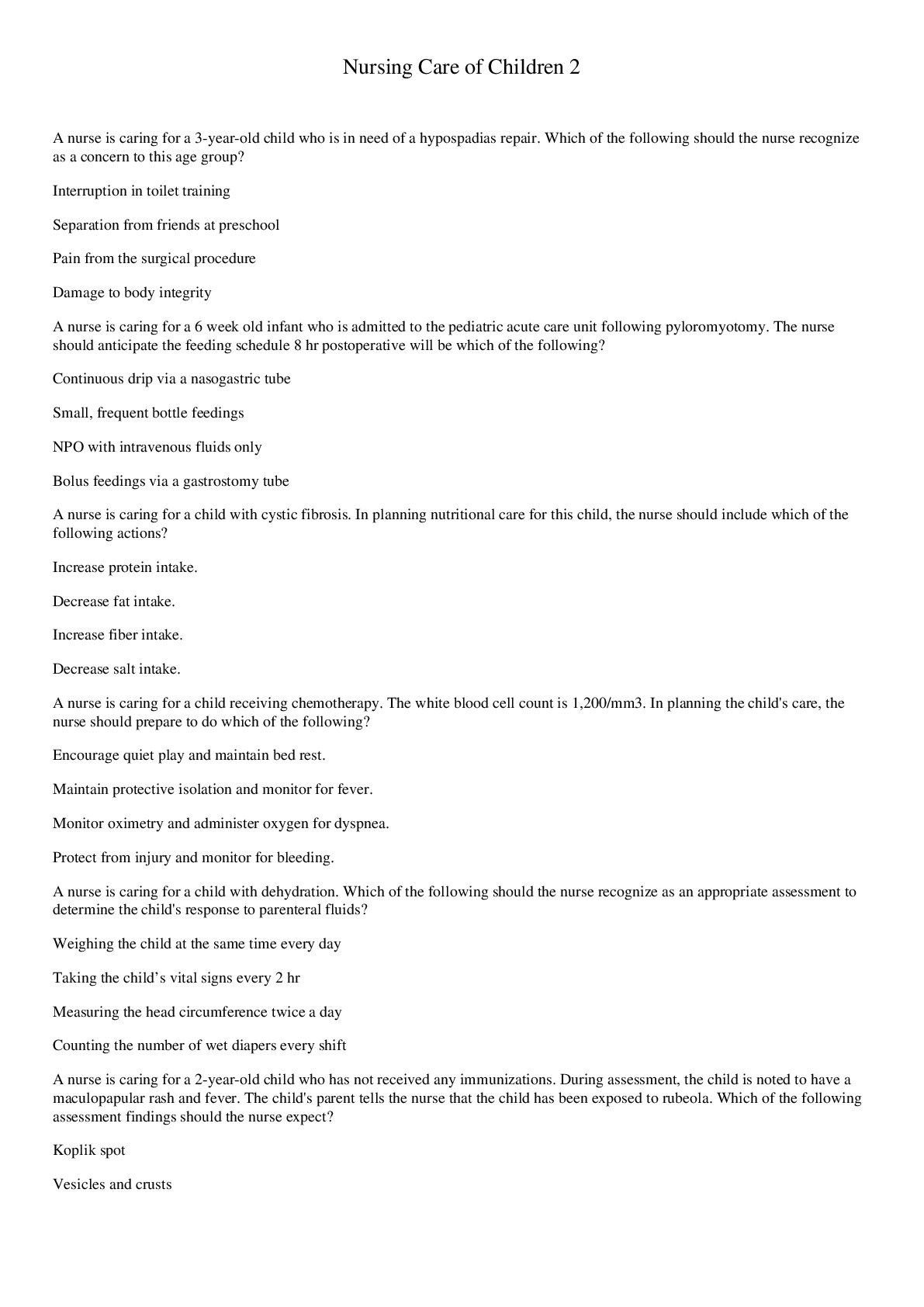
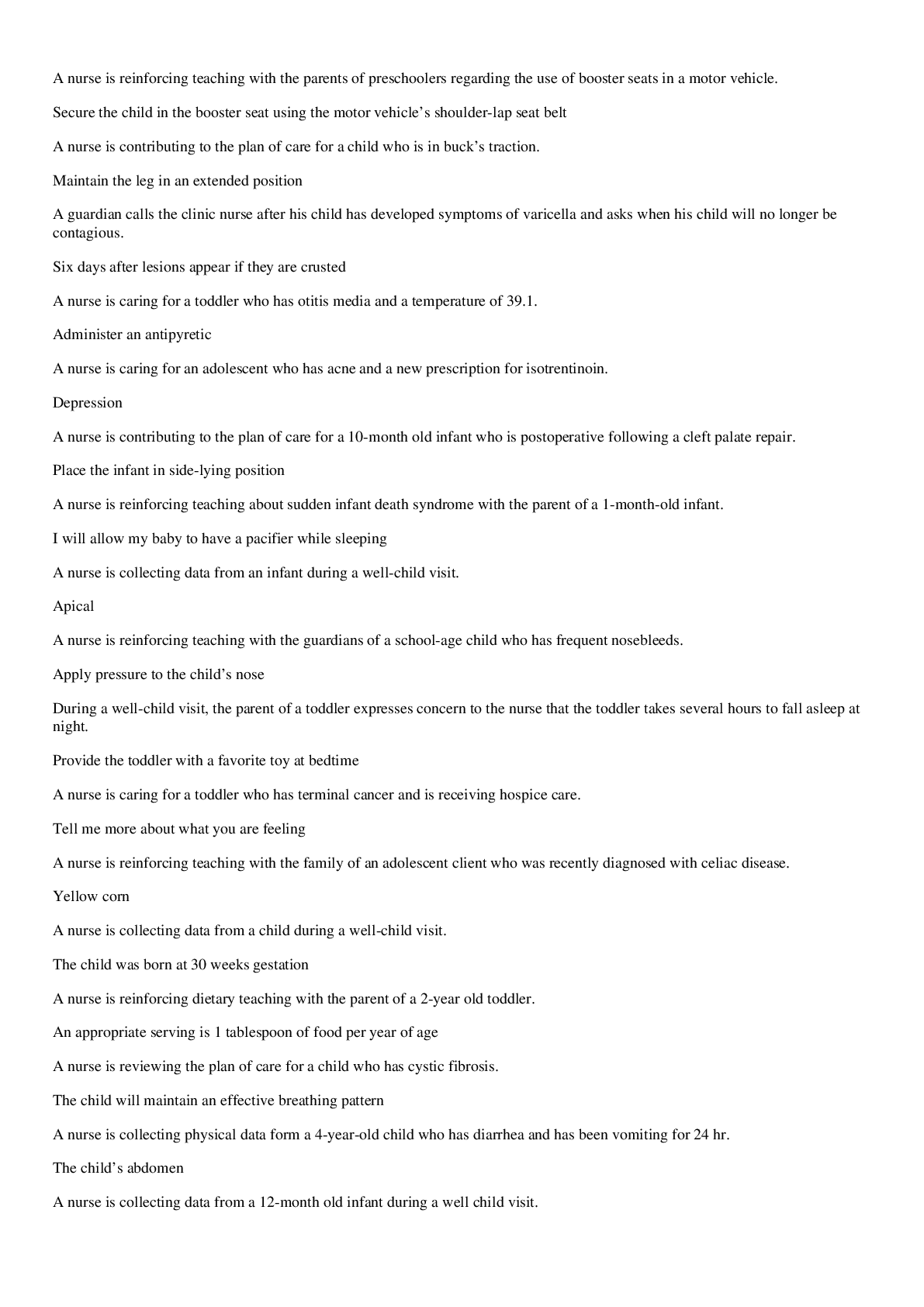
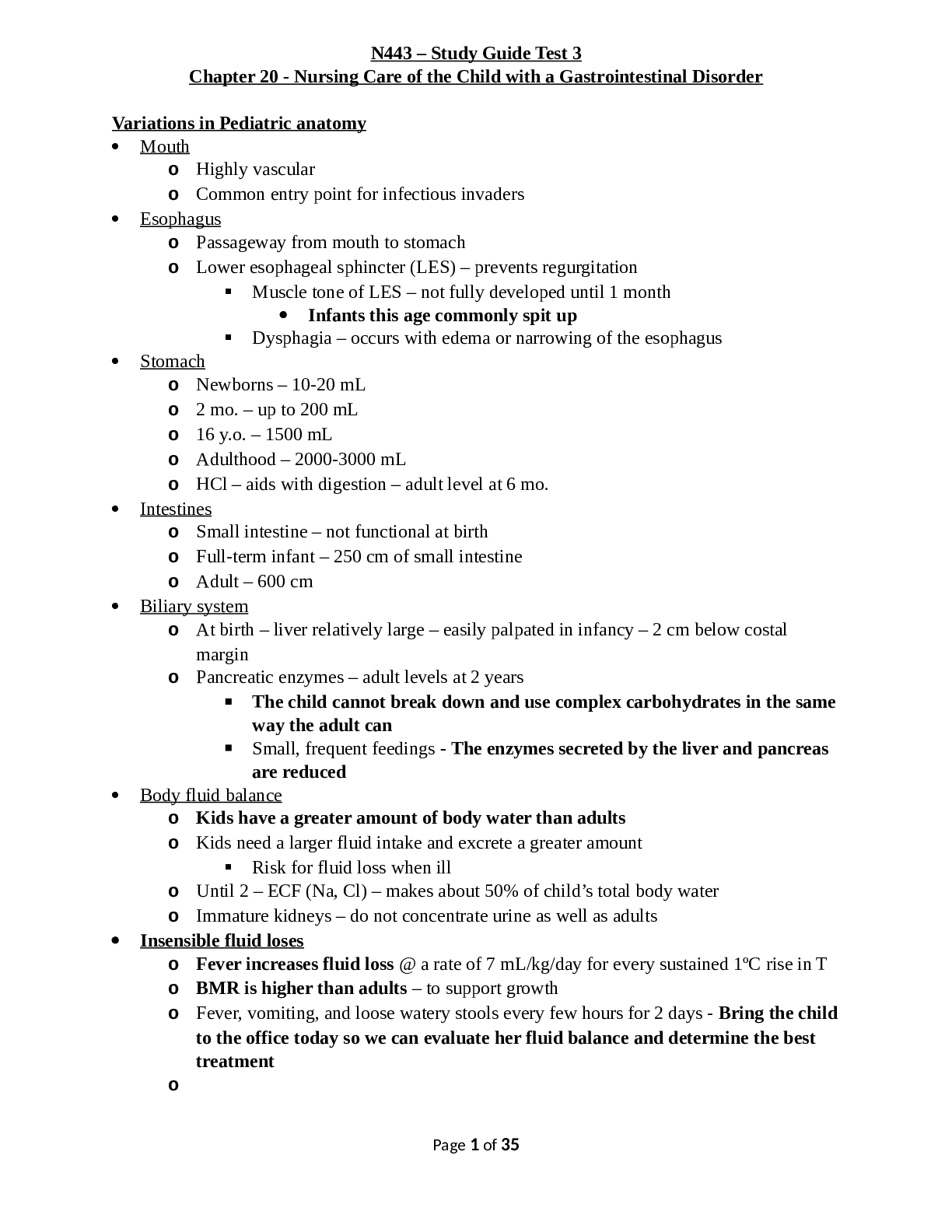
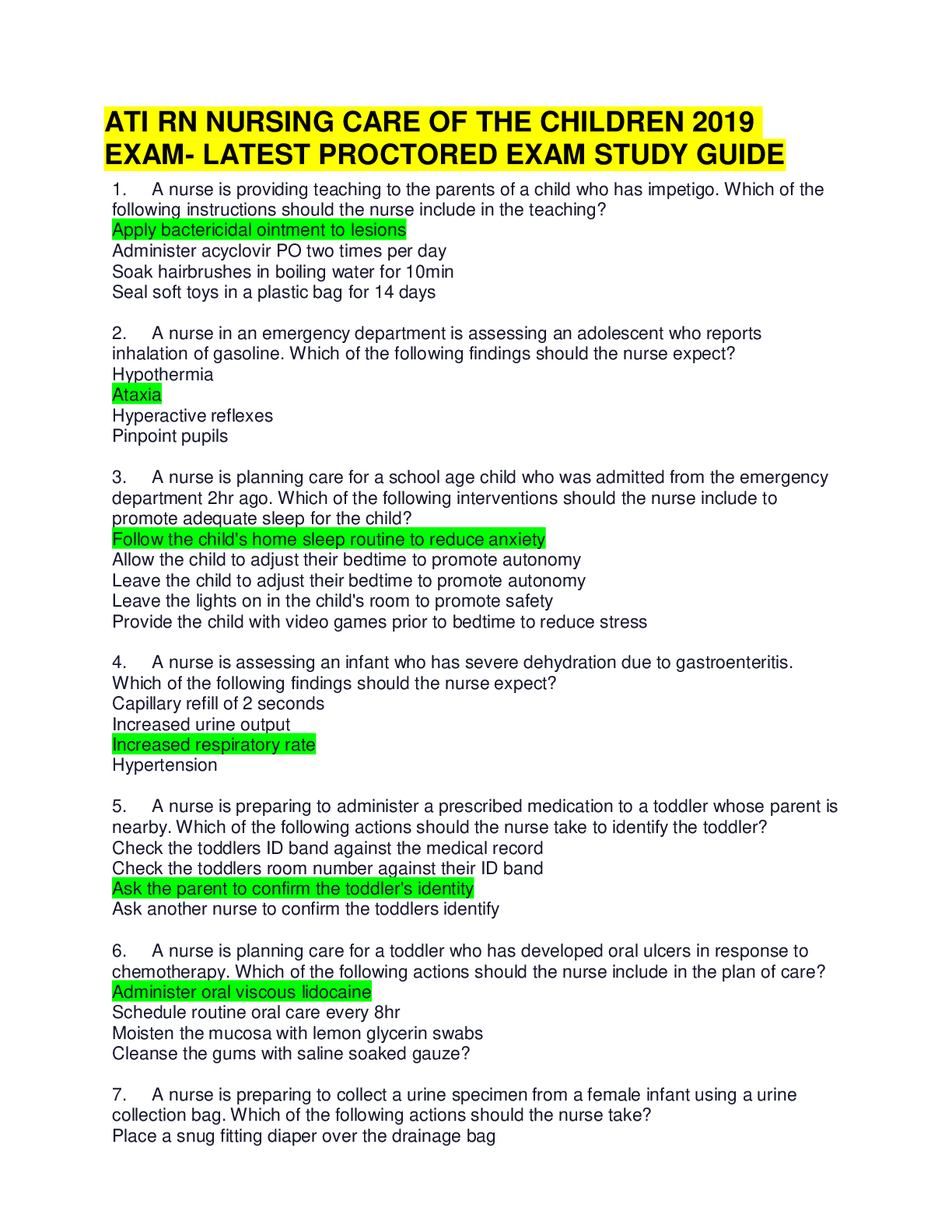
 (1).png)
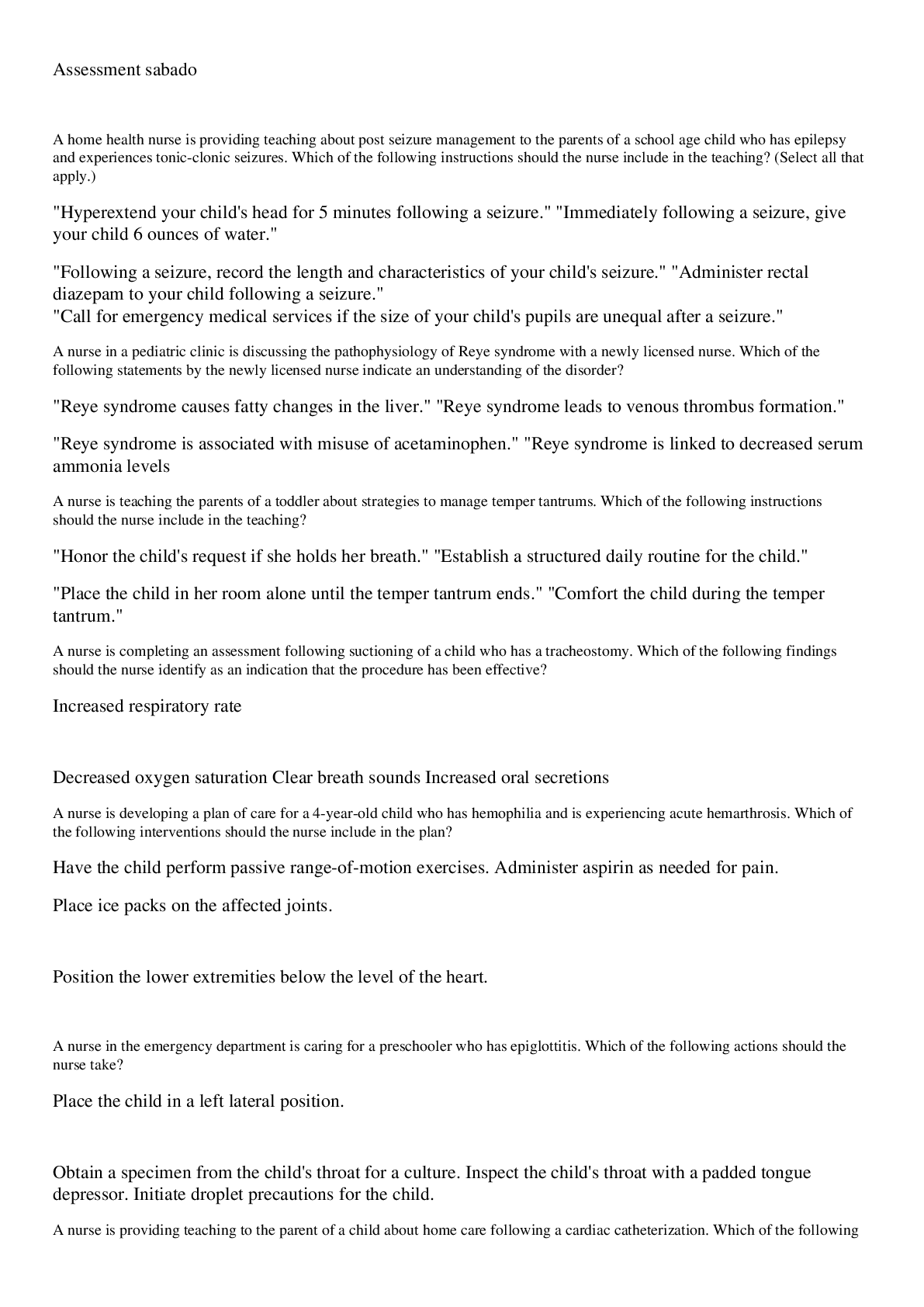
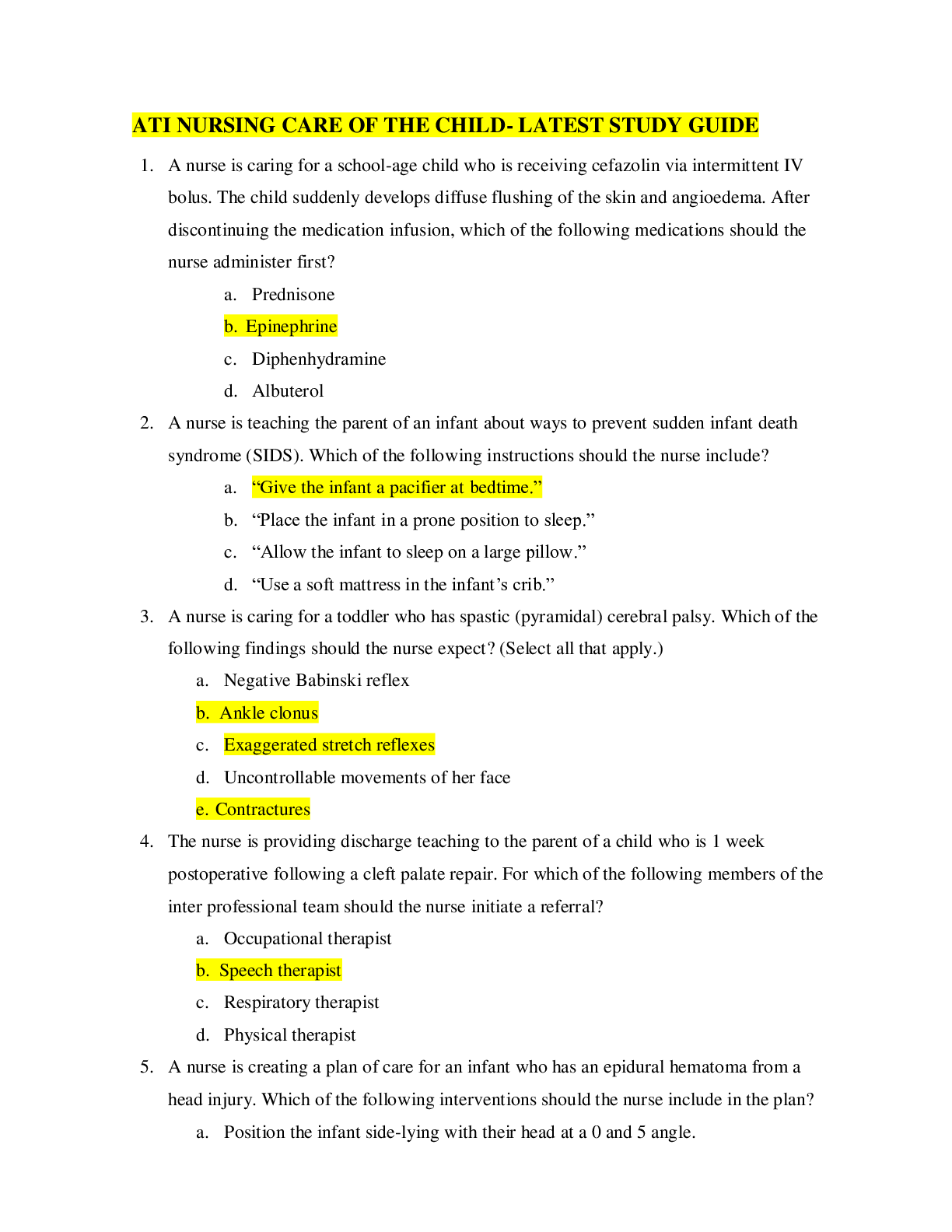
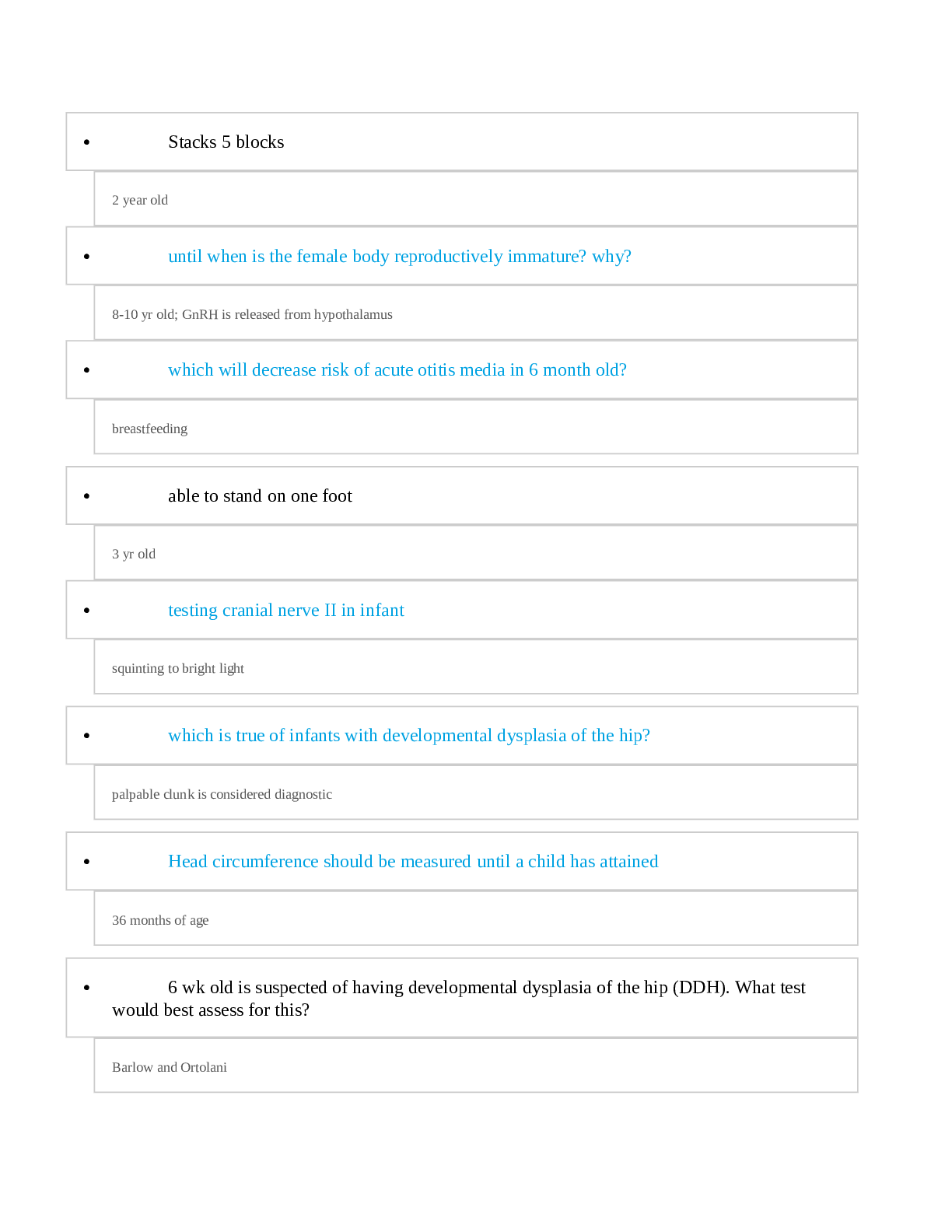
.png)
